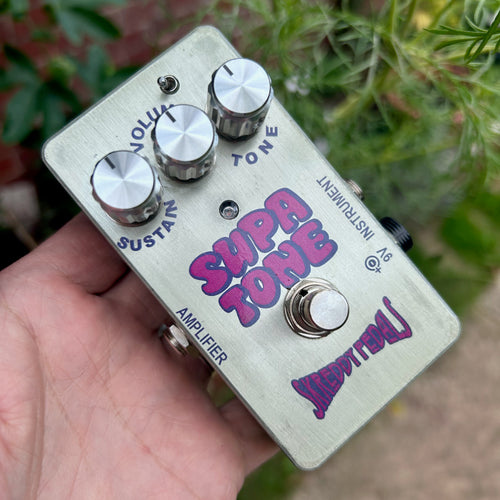Effect: Compressor
The CompIQ TWAIN MK2 is an advanced tool for analog dynamic audio processing of bass, guitar, and keyboard signals, among other applications. Its extensive features provide exceptional control over compression parameters, enabling users to achieve outstanding sound quality and tonal characteristics. With its Auto Timing settings, the TWAIN is easy to set up and adjust for professional results. At the the flip of a switch, the TWAIN can function either as a dual-band compressor/limiter with a variable crossover point or as two stacked compressors with separate controls for each.
The optional DITOS Transformer-Coupled Balanced Output DI is available as an add-on. Built with Burr-Brown™ technology and advanced line drivers, the DITOS provides complementary signal conditioning and a warm musical voicing to any instrument.
Built around the top-tier 4320 Analog Engine® from THAT Corp. and Texas Instruments FET Burr-Brown™ technology, the CompIQ TWAIN MK2 offers compression parameters that are usually available on professional studio equipment. In addition to its dual-band processing capabilities, the pedal’s two independent analog engines can be fully merged in series to attain the warm compression character typically found in optical compressors – a distinctive attribute, previously unavailable with this degree of customization.
The CompIQ TWAIN offers more than just compression, it includes preamp-like functions to enhance your instrument’s tone without needing a separate EQ. By adjusting the processing levels on each band, you can easily de-balance Lows and Highs around the crossover point and blend Dry over the compressed Wet-line. This technique adds dynamic character while preserving the original tone of the instrument.
The preamp section lets you adjust the input signal level to control how much the compressors engage. Strong signals can trigger compression too early, and the preamp offers up to -12dB of padding. Weaker signals can be boosted by up to +12dB of gain to help with less powerful passive pickups. The preamp works on both Wet and Dry lines simultaneously and can act as a simple one-knob balancer when switching between instruments.
A Peak-level indicator signals Green at -2dBu, showing the strength of the input signal, considering the preamp’s amplification or cutting. It turns Red when Twain’s output stages hit +2dBu due to the preamp and make-up gains acting in series. Intermittent Green and Red signals indicate a fairly leveled, cleanly processed signal. If both thresholds are reached simultaneously, the indicator turns Orange. If Orange or Red indication is steady, level readjustments may be needed for an optimal professional line-level signal.
The Twain MK2 offers two selectable compression modes for both Lows and Highs engines, with an additional combination of Feed Forward for Lows and Feed-Back for Highs. Feed Forward mode emphasizes speed and accuracy, using a pre-VCA input signal copy and can range from subtle compression to brick-wall limiting. Feed-Back mode provides a smooth and transparent response for evening out dynamics, using a post-VCA signal copy, and is ideal for low-to-medium compression ratios. Though Feed-Back mode is less suited for hard peak-limiting, it can still act as a genuine soft limiter by adjusting the threshold, using a hard knee, selecting a higher ratio, setting fast timing, and boosting the side chain filter’s control signal. Both modes sound clean and natural, free from pumping, breathing, distortion, or other artifacts.
Additional improved features are have been introduced for the side-chain processing. A variable Lo-cut/boost filter (±12dB @ 70Hz, 12dB/octave) is available on the Lows engine. This filter prevents high-amplitude low frequencies from touching the threshold too early, which can cause over-compression of the upper-frequency elements. Cutting lows in the side-chain reduces compression in the lows at the output, naturally restoring overall signal energy. Conversely, boosting lows in the side-chain helps increasing compressor sensitivity for lower-level signals.
A matching variable Hi-cut/boost filter (±9dB @ 3kHz, 12dB/octave) on the Highs side-chain engine further refines this balance. Cutting highs in the side-chain prevents their over-compression, maintaining natural audio brightness at the output, while boosting highs in the side-chain increases Highs compressor’s sensitivity to these frequencies, which helps with over-bright instruments.
When both Side Chain Filters are set to cutting, the compressor remains more sensitive to mid-frequencies, resulting in more compression in this range. With filter knobs set at noon, the side chain processing uses the full-frequency range signal derived from the input.
These advanced features help manage compression across lows, mids, and highs, providing dynamic impact without unwanted pumping and maintaining general audio balance.
The CompIQ TWAIN offers independent controls for Hard/Soft Compression Knee, a 50dB Threshold range for instruments and line-level sources, continuous Ratio selection from 1:1 to limiting, and up to +20dB of Make-up Gain.
The inclusion of Dynamic Auto Timing (Fast / Slower presets) for both bands reduces setup complexity of a dual-band compressor and provides a musical response that is suitable for virtually any musical application.
The optional DITOS Transformer-Coupled Balanced Output DI is an add-on feature. Utilizing ultra-quiet FET Burr-Brown™ technology and advanced line drivers, it delivers superior performance, complementary signal conditioning, and a warm, musical voicing. The 1/4″ TRS output supports direct recording or sending the signal to a mixing console and can also function as an unbalanced floating output for use with a TS mono plug, sending the signal to another pedal or amplifier. The main VCA output remains functional at all times.
When Twain is in bypass, the DITOS circuit still processes the signal, providing active compression bypass, while the main VCA output is true-bypassed. An internal ground-lift jumper is available to address potential ground-loop noise issues. Since the Twain circuit and optional DITOS output DI share active components, there’s a slight signal level difference between powered and non-powered bypass due to the DITOS’s always-connected active load.
The Twain MK2 is remarkably powerful and versatile.
CompIQ TWAIN Pro Dual Band / Stacked Compressor






